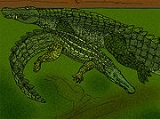
Baru
Encyclopedia
Baru was an extinct genus
of Australian mekosuchine crocodilian. It was semi-aquatic, around 4 m (13 ft) in length. Being semi-aquatic its habitat was around fresh pools of water in wet forests, ambushing their prey, much like modern species. The word Baru is Aboriginal and means "crocodile's ancestor".
Fossils have been found in Australia at Riversleigh
in north-western Queensland
and Alcoota Station it the Northern Territory
.
B. darrowi is known from the Middle Miocene
of the Northern Territory and is the largest reaching size of 4-5 m in length, whilst two older species, B. huberi and B. wickeni are known from the Late Oligocene
of Queensland.
Genus
In biology, a genus is a low-level taxonomic rank used in the biological classification of living and fossil organisms, which is an example of definition by genus and differentia...
of Australian mekosuchine crocodilian. It was semi-aquatic, around 4 m (13 ft) in length. Being semi-aquatic its habitat was around fresh pools of water in wet forests, ambushing their prey, much like modern species. The word Baru is Aboriginal and means "crocodile's ancestor".
Fossils have been found in Australia at Riversleigh
Riversleigh
Riversleigh, in North West Queensland, is Australia's most famous fossil site. The 100 km² area has fossil remains of ancient mammals, birds and reptiles of Oligocene and Miocene age...
in north-western Queensland
Queensland
Queensland is a state of Australia, occupying the north-eastern section of the mainland continent. It is bordered by the Northern Territory, South Australia and New South Wales to the west, south-west and south respectively. To the east, Queensland is bordered by the Coral Sea and Pacific Ocean...
and Alcoota Station it the Northern Territory
Northern Territory
The Northern Territory is a federal territory of Australia, occupying much of the centre of the mainland continent, as well as the central northern regions...
.
Species
There are currently three valid species within the genus Baru. The type speciesType species
In biological nomenclature, a type species is both a concept and a practical system which is used in the classification and nomenclature of animals and plants. The value of a "type species" lies in the fact that it makes clear what is meant by a particular genus name. A type species is the species...
B. darrowi is known from the Middle Miocene
Miocene
The Miocene is a geological epoch of the Neogene Period and extends from about . The Miocene was named by Sir Charles Lyell. Its name comes from the Greek words and and means "less recent" because it has 18% fewer modern sea invertebrates than the Pliocene. The Miocene follows the Oligocene...
of the Northern Territory and is the largest reaching size of 4-5 m in length, whilst two older species, B. huberi and B. wickeni are known from the Late Oligocene
Oligocene
The Oligocene is a geologic epoch of the Paleogene Period and extends from about 34 million to 23 million years before the present . As with other older geologic periods, the rock beds that define the period are well identified but the exact dates of the start and end of the period are slightly...
of Queensland.

